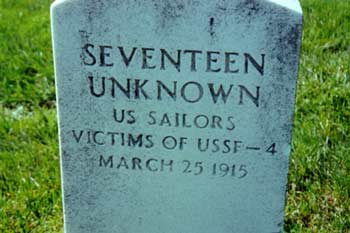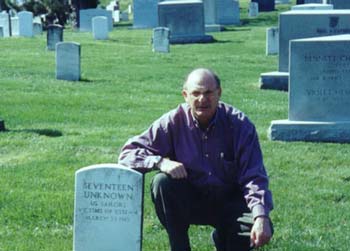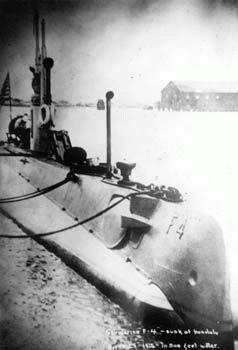

|
|
It was 85 years ago yesterday that the United States lost its first submarine during a tragic accident that delivered 21 men to a watery death less than two miles off Honolulu's Pearl Harbor. On March 25, 1915, the USS F-4 left the harbor on a routine training exercise but never returned. Bold attempts to rescue its trapped crew proved futile, and it took five months before an extraordinary salvage operation by the U.S. Navy brought the sunken boat to the surface.
Until now, those lost sailors have been remembered only in the minds of a few historians and their few living relatives, though the fate of their boat was no less tragic than others that lie in Pearl Harbor's murky depths. Of the 21 dead eventually recovered, only four were identified, their bodies shipped home to loved ones. Seventeen remained unidentified and were interred in Washington, D.C.'s Arlington Cemetery, where their grave was marked hastily by a simple tombstone normally engraved for one person: "Unidentified remains of the F-4."

THE SEARCH FOR A SIMPLE STONE
For Richard B. "Guns" Mendelson, chaplain and rabbi of the U.S. Submarine Veterans, Capitol Base, this inadequate remembrance is a dishonor to the 21 seamen who died so tragically while serving aboard one of the Navy's earliest submarines.
The U.S. Submarine Veterans Inc. is a nationwide organization of 6,000 members whose creed is "to perpetuate the memory of our shipmates who gave their lives in the performance of their duties, that their dedication, deeds and supreme sacrifice be a constant source of motivation toward greater accomplishment." In 1999, Mendelson's Capital Base veteran's group conducted the first-ever memorial service solely for submarine sailors.
Last year, in preparation for the second annual memorial service, the veterans began looking for grave of the F-4 crew in Arlington Cemetery. One of its members read about the ill-fated boat in Sea Stories magazine and was inspired to find the site.
For weeks, as many as 10 veterans searched Arlington Cemetery for the grave, but only in vain. Old, poorly kept records, the enormity of the facility and the small size of the headstone made it a daunting task. Even with a definite section and grave number, it took months to locate the site, and only then with the help of Tom Sherlock, an Arlington historian.
" We left the cemetery speechless
I looked back at the hill where
they were buried and then to our
group. There was not one dry
eye ... How sad it is that these
submarine pioneers gave their
lives for us and we have never
acknowledged their sacrifice or
existence."
Richard B. Mendelson
"Each section of Arlington Cemetery is odd-shaped and very large," Mendelson said. "Thousands of headstones of every shape and description make it almost impossible to locate one individual marker. The records from that era are not very well kept and there is so much activity with newer sites from the Vietnam era that the past gets buried along with the remains. Surely we walked by the grave several times without noticing it."
The veterans were shocked and saddened by the size and condition of the stone. "It was dirty, deteriorating and entirely too small for the 21 victims of the F-4," Mendelson says. "We left the cemetery speechless. I looked back at the hill where they were buried and then to our group. There was not one dry eye. For 85 years they have been lying there watching silently while visitors walk past without any recognition. How sad it is that these submarine pioneers gave their lives for us and we have never acknowledged their sacrifice or existence."
A REMEMBRANCE DESERVED
The fallen crew of the F-4 will get that acknowledgement on May 28, when the U.S. Submarine Veterans Inc. of the Capitol Base and the Northern Virginia Submarine Base conduct a full military memorial ceremony at the gravesite in Arlington Cemetery. The event will include the Navy honor guard, a drum and bugler and a veteran's color guard. A tolling of the bells ceremony will be held simultaneously for the 51 lost submarines and 3,800 sailors who have died in service to the United States.
Mendelson researched the F-4 disaster at the National Archives in Washington, D.C., where he found a list of its crew, their hometowns and next of kin. Determined to find as many living relatives of the F-4 crew as possible before May 28, he searched the internet using the last names and hometowns, and sent hundreds of letters and postcards throughout the United States. So far, four groups of relatives have responded, and Mendelson says his phone is ringing off the hook with information and inquiries about these relatives.

A more fitting memorial listing the complete names and ranks of the crew that went down with it will replace the F-4 headstone, and a large display of the F-4 will be on permanent display at the National Navy Memorial in Washington, D.C.
"These brave men were in every respect pioneers," Mendelson said. "Being in a submarine under any conditions, during war or peace, is stressful. We as submarine veterans must remember our heritage for the sailors of the future. They deserve to know what we and our forefathers were willing to sacrifice."
It is apparent that these men did not join the submarine service in 1915 for money. They earned about $38 per month, and once qualified, received $1 a month more. In some cases, Mendelson says, they got an extra buck for each submarine dive. "It takes a special person to venture beneath the sea in such a primitive machine," he says. "These men unknowingly paved the way for the Navy to realize it had come up with a way to save sub crews and raise sunken subs."
RELATIVES REMEMBER
Mendelson's memorial committee has sent out hundreds of letters of inquiry in an attempt to find all the living relatives of the F-4 crew. So far, only four families have responded.
The Withers family, in California, is one of them. "The people who really would have loved (the memorial) were my father- and mother-in-law," said Nati Withers, whose husband, 76-year-old John, was the nephew of F-4 casualty Henry Withers.
Henry Withers was 28 years old and a 14-year Navy veteran when he died 85 years ago yesterday.
"My mother had an affection for (Henry), and she was always saddened when she spoke of him," recalled John Withers, who says he, too, has a "feeling of sadness" when recalls the story of his uncle's demise.
"My mother-in-law used to talk about how she knew that when she saw her husband walk up the driveway in the middle of the day that something was wrong," Nati Withers recalled. "Her husband owned a butcher shop, and he wouldn't have left the shop in the middle of the day. She knew something urgent or terrible had happened."
100 YEARS OF SILENT SERVICE
This year's submarine memorial service at Arlington Cemetery is unique, as it is part of the 100th anniversary of the U.S. Submarine Service. It is only one of many events taking place across the country to commemorate the event, including the release tomorrow of the Submarine Centennial Stamp by the U.S. Postal Service.
The Navy's first step towards the modern nuclear submarines of today was the launch of the USS Holland, the first submarine to be put into service, on April 1900. During World War II, the submarine force made up only 3 percent of the Navy, yet its sailors and their submarines accounted for 55 percent of all the ships that were sunk by allied forces. It has the highest casualty rate per capita of any service in the United States. The U.S. Navy lost 52 submarines and 3,500 men during that time, and seven submarine commanding officers were awarded the Medal of Honor for their efforts. Since then, the United States has lost two additional submarines and their crews.
"The F-4 represents more than 3,800 men who went down with their submarines during the past 100 years," Mendelson said. "It can and will be remembered as long as there is a submarine in service. Her loss represents a willingness of all submarine sailors to protect our freedom."
Hawai`i's USS Bowfin Submarine Museum & Park also plans to erect a new memorial near Pearl Harbor next month in remembrance of all U.S. submariners who were lost before and after World War II, including the F-4.